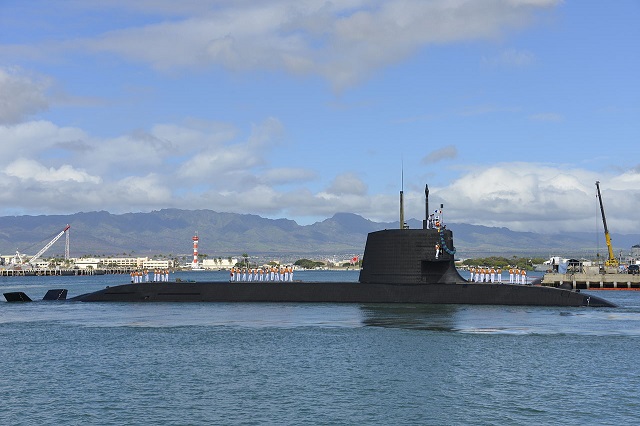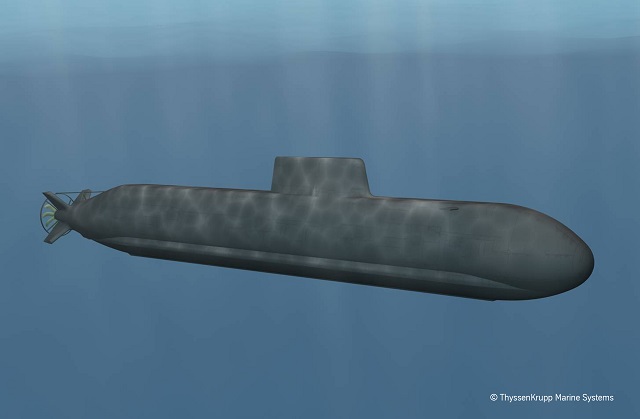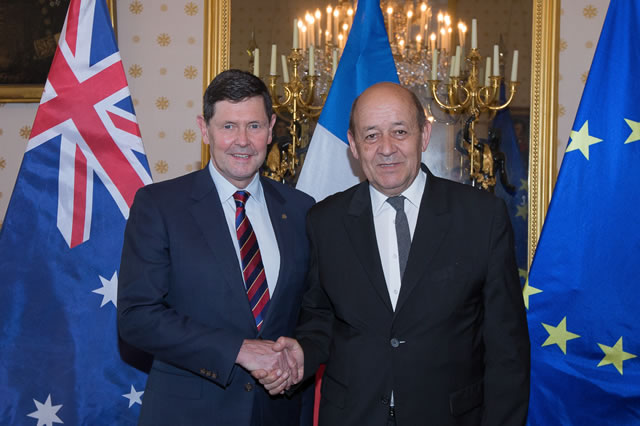| |
|||
| a | |||
Focus - Australia's Submarine Replacement Programme |
|||
Strengths
& Weaknesses of the Contenders for Australia's Submarine Replacement
Programme |
|||
By
Xavier Vavasseur Plans to replace the existing Royal Australian Navy's (RAN) Collins-class submarines began in 2007 with the launch of "SEA 1000" also known as the Future Submarine Programme. In February this year, the Australian Government announced the acquisition strategy for the Future Submarine Program and invited three countries: France, Germany and Japan to participate in a competitive evaluation process. Here is our analysis of the strengths and weaknesses of each contender: » The Japanese Soryu class » The German Type 216 » The French evolution of SSN Barracuda |
|||
 The
Royal Australian Navy aims at replacing its Collins-class submarines
(HMAS Rankin pictured) The
Royal Australian Navy aims at replacing its Collins-class submarines
(HMAS Rankin pictured)(U.S. Navy photo by Mass Communication Specialist Seaman James R. Evans) |
|||
Before we start focusing on each of the three contenders,
it is important to understand the fairly new and unique requirements
of the RAN. So far and to this day, the majority of export submarines
(such as the Kilo, Type 212 and 214, Scorpene, Agosta, A17…) displace
around 2000 tons. They answer the needs of navies looking to patrol
their coastal area, maritime approaches. Deployment on farther operational
theatres requires long weeks of transit and probably port call for refueling
and other logistic needs. The RAN needs are fairly unique (even though
both TKMS and DCNS somewhat anticipated these needs) as it is looking
for a multi-role, long endurance, long range submarine able to take
part in joint operations with its allies. The combination of these factors
translates into a well above 3000 tons submarines design. In addition,
Navy Recognition understands the general consensus is that no matter
which design gets selected, the RAN requires it to be fitted with US
made combat management system (CMS) and weapons.
|
|||
 Japan
Maritime Self Defense Force (JMSDF) Soryu class submarine Hakuryu (SS-503) Japan
Maritime Self Defense Force (JMSDF) Soryu class submarine Hakuryu (SS-503)(U.S. Navy photo by Cmdr. Christy Hagen/Released) |
|||
Soryu class submarine
Throughout 2014, several news outlets (all of them US based such as Reuters) tried to infer that the Soryu class was favored by Australia and the procurement of Japanese submarines was almost a “done deal”. Today’s situation however appears to be more complicated for the Soryu as the Australian government decided to study proposals from two extra competitors. The strengths of the Soryu class are: - it appears as the only sea-proven design of the three contenders - it is favored by the United States for political reasons (driven by the "Shift to Asia-Pacific region") - because of the aforementioned political reasons, the aspects of US CMS and weapons are non-issues. But will the Soryu really answer Australia’s needs? Looking closely at its reported performance it must be noted that these performance are actually quite similar to existing small or medium modern SSK such as the Kilo, Scorpene or Type 214. The reason may simply be the needs and doctrine of the Japan Maritime Self-Defense Force (JMSDF): Looking at a map of Japan, one may realize that as soon as it leaves its base, a Soryu class SSK is already in patrol in proximity to North Korean or Chinese waters.  To match the Australian needs for long range and endurance, the Soryu will have to be modified with a new Air Independent Propulsion (AIP) system and new Lithium Ion batteries among other things. In other words the end result would almost be a new submarine because of the major modifications required: For example, fitting new Lithium Ion batteries means a completely new electrical architecture, new ventilation schematics, newly designed engines to optimize the use of the batteries… Another issue with the Soryu is Japan’s lack of experience in the fields of transfer of technology and industrial cooperation related to complex defense programmes. |
 The
Type 216 is TKMS' long-range submarine project. Picture: ThyssenKrupp
Marine Systems The
Type 216 is TKMS' long-range submarine project. Picture: ThyssenKrupp
Marine Systems |
|||
Type 216 submarine
Revealed at Euronaval 2012, the Type 216 is German Shipbuilder TKMS' view of what a conventional propulsion long-range submarine should be. The strengths of the Type 216 is that it is fully compliant (on paper) with the needs of "ocean going" navies (such as the RAN) looking for long-range submarines. In addition TKMS' past and present order book speaks for itself: TKMS submarines of all types (209,210,212A,214) are in service with the navies of 17 countries in addition to the German Navy. Finally, unlike the Japanese offer, TKMS is used to complex defense programmes cooperation with local partners. However, what may limit the Type 216 chances in the SEA 1000 programme is uncertainty on two aspects: The first uncertainty aspect is TKMS' lack of experience in building large submarines. The design of submarines requires a pre-sizing capability: For example, the basic requirements in terms of speed and endurance drive the electrical and engine power requirement of the submarine which themselves impact the volumes and compartments of the submarines. This pre-sizing capability is based on both experience and empirical knowledge.The design rules (which may even be considered "empirical laws") when building submarines are not linear. In other words, TKMS will not be able to use all of its extensive experience in building under 2,000 tons submarines if it ever starts constructing the 4,000 tons Type 216 one day. Again, the pre-sizing phase is critical. Navantia's (which is another reputable shipbuilder based in Spain) issues with the S80 class SSK is a recent example. The first unit of this new type of submarine needs to be redesigned because a "weight imbalance" was detected. In a large submarine, all of the equipment needs to be "over sized" and this impacts everything on board: Larger or more machinery implies larger or more sea water circuit which requires more weight and room... A submarine designed for long range and endurance needs to be designed with more reliability, more redundancy and even a workshop for maintenance on the go (as is found on board most nuclear submarines [SSN]). Last but not least, other important parameters need to be considered such as human factors (possibly more space for the crew, better atmosphere, more fresh water...). The second uncertainty aspect is the issue of US made CMS and weapons. Nothing guarantees that the US government will agree to share sensitive CMS data and weapons blueprints with TKMS for integration. While some TKMS built submarines are fitted with UGM-84 Harpoon (with the Portuguese Navy Type 214), it remains to be seen whether the US will agree to share its Tomahawk cruise missile data with Germany. |
|||
 A
Barracuda type (Suffren class) SSN. Picture: French Navy A
Barracuda type (Suffren class) SSN. Picture: French Navy
|
|||
Evolution of SSN Barracuda into a conventional
submarine
DCNS proposes an evolution of the Barracuda type SSN - currently in production for the French Navy- into a conventional submarine fully compliant with the needs of “ocean going” navies. The main strength of this submarine is that it exceeds the capabilities of its competitors in terms of speed, endurance and weapons. According to DCNS, a number of key innovations give the submarine a truly outstanding performance.  * NB: These performances are those of the nuclear version.
* NB: These performances are those of the nuclear version.The transit speed is at least 40% higher than those of its competitors which is significant. It is important to understand that the faster a submarine can deploy, the more operational it becomes because it can spend more time in the mission area. Like TKMS, DCNS is used to complex defense programmes cooperation with local partners so the industrial aspect is definitely not a problem. There may even be some historical commonality if Australia selects the DCNS solution: The Collins class submarines currently deployed by the RAN are fitted with French Jeumont-Schneider engines, a manufacturer present in all DCNS submarines. Likewise, many systems on board the Collins class such as the sonar systems are Thales products, and so is the case for all DCNS submarines. Last but not least, DCNS has extensive experience in designing and building large submarine since the company was in charge of designing and building the (former) Redoutable and (current) Triomphant class ballistic missile submarines (SSBN), the backbone of French nuclear deterrence. The main factor that is not in favor of DCNS is again the issue of US made CMS and weapons. The issue is definitely not technical: Since the Agosta 90B, DCNS submarines are "open architecture" to facilitate the integration of new systems and weapons (therefore the installation of a CMS and weapons of American origin are not a technical problem). Regarding that (political) aspect, DCNS is in the same situation as TKMS: nothing guarantees that the US government will agree to sharing information for weapons and systems integration. |
|||
 In
April 2015, the Chief of Royal Australian Navy, Vice Admiral Tim Barrett,
and Australia's Defense Minister, the Honorable Kevin Andrews (pictured
here with France's Defense Minister) visited TKMS in Germany and DCNS
submarine shipyard in France. In
April 2015, the Chief of Royal Australian Navy, Vice Admiral Tim Barrett,
and Australia's Defense Minister, the Honorable Kevin Andrews (pictured
here with France's Defense Minister) visited TKMS in Germany and DCNS
submarine shipyard in France. |
|||
The formal RAN requirements for the Collins submarines
replacement have not been made public yet, but like in many international
procurement contracts, it is likely that political aspects will be given
priority with the technical aspects coming a distant second. It appears
also that no matter which platform Australia selects, their American allies
will give the ultimate "green light"... or not.
That being said, despite many US media picturing the Japanese Soryu as a "done deal" last year, Australia is giving full consideration to the three contenders invited to participate in a competitive evaluation process earlier this year. A simple illustration of this fact: The visit last April by the Chief of Royal Australian Navy, Vice Admiral Tim Barrett, and Australia's Defense Minister, the Honorable Kevin Andrews, of TKMS shipyard in Germany and then of DCNS shipyard in Cherbourg (where the Barracuda type SSNs are being assembled for the French Navy). |
|||










